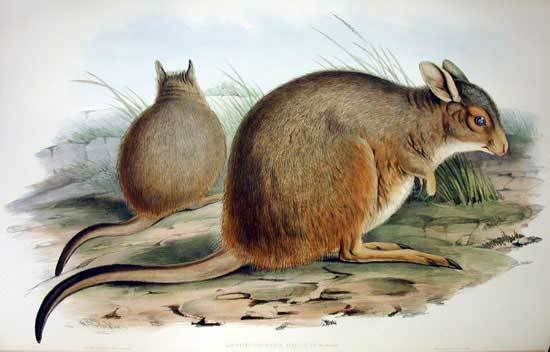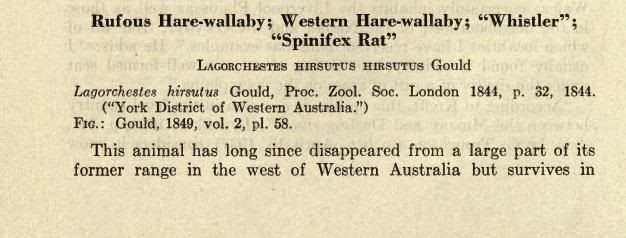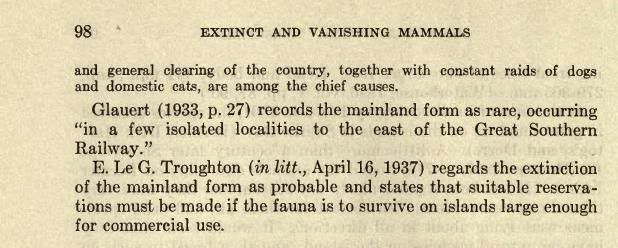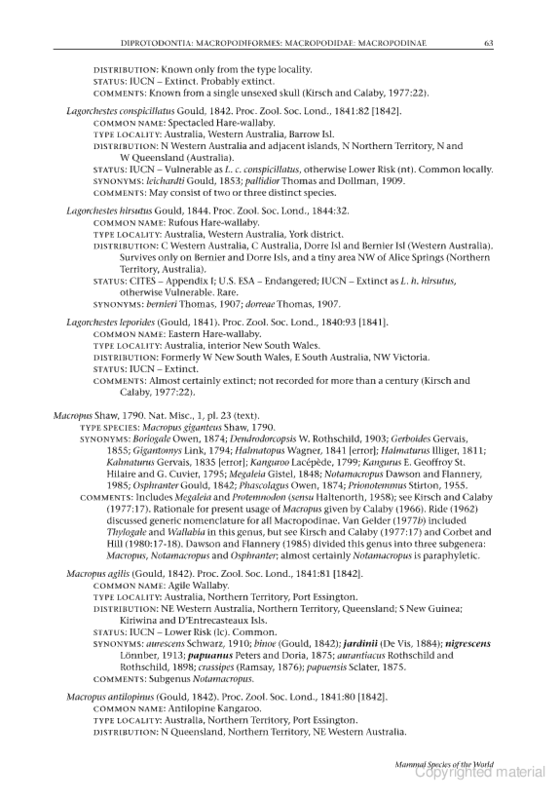Post by another specialist on Sept 9, 2007 18:57:46 GMT
Rufous hare-wallaby
The rufous hare-wallaby was described in 1844 from specimens obtained by John Gilbert in south-western Western Australia (Gould 1844). There are currently three subspecies recognised: Lagorchestes hirsutus hirsutus from mainland Australia, L. h. bernieri from Bernier Island, and L. h. dorreae from Dorre Island (Thomas 1907; Maxwell et al. 1996). Courtenay (1993) found differences in cranial morphology between the island populations and central and western Australia mainland populations, and suggested that the extinct L. h. hirsutus described from the York district of south-west Western Australia may be a separate subspecies to the undescribed L. hirsutus from central Australia.
Two small wild populations remained until recently in the Tanami Desert but were extirpated in 1987 and 1991. The only surviving animals from these populations are now housed in captivity (Monarto Zoological Park in South Australia, Western Plains Zoo in New South Wales, Parks and Wildlife Commission of the Northern Territory Arid Zone Research Institute, the Watarrka National Park, and Alice Springs Desert Park in the Northern Territory, and Dryandra Field Breeding Facility, and the Peron Captive Breeding Facility within François Peron National Park in Western Australia; Langford 2001) or have been translocated to a secure site on Trimouille Island in the Montebello Islands off the Pilbara Coast in Western Australia (Burbidge et al. 1999). A reintroduction to Peron Peninsula in Shark Bay was not successful (Morris et al. 2003). The species survives only as wild populations on Bernier and Dorre Islands in Shark Bay, Western Australia. There are no captive populations of Bernier or Dorre Island stock.
Note: for the purposes of this report, the Bernier and Dorre Island subspecies will be referred to collectively as ‘rufous hare-wallabies’, excluding the mainland subspecies, unless otherwise stated.
The Dorre and Bernier Island subspecies are larger than those from central Australia, and have a shorter tail (Johnson and Burbidge 1995). Dorre Island animals have a shorter pes length, shorter tail length and longer head length than animals on Bernier Island (Richards et al. 2001). Bernier Island animals have shorter ears and are paler in colour, while Dorre Island animals are redder in colour and their skull is narrower between the orbits than the mainland form (Troughton 1967), supporting the original separation of the two island subspecies (Thomas 1907).
The rufous hare-wallaby is one of the ‘true’ hare-wallabies. It is one of the smaller macropods, which, like all the hare-wallabies, received its name from its supposed resemblance to the hare (Strahan 1995) and the rufous colour of their long, soft fur (Johnson and Burbidge 1995). The species has an average weight of 1750 g and there are no differences in body weight, hind foot length, head length, crus length, tail length and diameter or head/body length between the sexes (Richards et al. 2001).
The species is herbivorous, and has been found throughout Bernier and Dorre Islands in habitat dominated by heath, dunes, and Triodia hummock grassland (Short and Turner 1992). Rufous hare-wallabies shelter during the day in small scrapes, half hidden beneath bushes or spinifex clumps (Shortridge 1909). On Bernier and Dorre Islands they may use single-entrance burrows of about one metre in length and 30 cm depth (Short and Turner 1992). On the mainland they have been found in areas dominated by mature Triodia (Bolton and Latz 1978), low scrub (Gould 1863), and spinifex-mulga country (Finlayson 1935). They tend to be solitary animals, however there was some evidence of social organisation within animals maintained in a captive colony (Lundie-Jenkins 1993b).
www.cse.csiro.au/publications/2003/sbmarsupialsrecpln.pdf
The rufous hare-wallaby was described in 1844 from specimens obtained by John Gilbert in south-western Western Australia (Gould 1844). There are currently three subspecies recognised: Lagorchestes hirsutus hirsutus from mainland Australia, L. h. bernieri from Bernier Island, and L. h. dorreae from Dorre Island (Thomas 1907; Maxwell et al. 1996). Courtenay (1993) found differences in cranial morphology between the island populations and central and western Australia mainland populations, and suggested that the extinct L. h. hirsutus described from the York district of south-west Western Australia may be a separate subspecies to the undescribed L. hirsutus from central Australia.
Two small wild populations remained until recently in the Tanami Desert but were extirpated in 1987 and 1991. The only surviving animals from these populations are now housed in captivity (Monarto Zoological Park in South Australia, Western Plains Zoo in New South Wales, Parks and Wildlife Commission of the Northern Territory Arid Zone Research Institute, the Watarrka National Park, and Alice Springs Desert Park in the Northern Territory, and Dryandra Field Breeding Facility, and the Peron Captive Breeding Facility within François Peron National Park in Western Australia; Langford 2001) or have been translocated to a secure site on Trimouille Island in the Montebello Islands off the Pilbara Coast in Western Australia (Burbidge et al. 1999). A reintroduction to Peron Peninsula in Shark Bay was not successful (Morris et al. 2003). The species survives only as wild populations on Bernier and Dorre Islands in Shark Bay, Western Australia. There are no captive populations of Bernier or Dorre Island stock.
Note: for the purposes of this report, the Bernier and Dorre Island subspecies will be referred to collectively as ‘rufous hare-wallabies’, excluding the mainland subspecies, unless otherwise stated.
The Dorre and Bernier Island subspecies are larger than those from central Australia, and have a shorter tail (Johnson and Burbidge 1995). Dorre Island animals have a shorter pes length, shorter tail length and longer head length than animals on Bernier Island (Richards et al. 2001). Bernier Island animals have shorter ears and are paler in colour, while Dorre Island animals are redder in colour and their skull is narrower between the orbits than the mainland form (Troughton 1967), supporting the original separation of the two island subspecies (Thomas 1907).
The rufous hare-wallaby is one of the ‘true’ hare-wallabies. It is one of the smaller macropods, which, like all the hare-wallabies, received its name from its supposed resemblance to the hare (Strahan 1995) and the rufous colour of their long, soft fur (Johnson and Burbidge 1995). The species has an average weight of 1750 g and there are no differences in body weight, hind foot length, head length, crus length, tail length and diameter or head/body length between the sexes (Richards et al. 2001).
The species is herbivorous, and has been found throughout Bernier and Dorre Islands in habitat dominated by heath, dunes, and Triodia hummock grassland (Short and Turner 1992). Rufous hare-wallabies shelter during the day in small scrapes, half hidden beneath bushes or spinifex clumps (Shortridge 1909). On Bernier and Dorre Islands they may use single-entrance burrows of about one metre in length and 30 cm depth (Short and Turner 1992). On the mainland they have been found in areas dominated by mature Triodia (Bolton and Latz 1978), low scrub (Gould 1863), and spinifex-mulga country (Finlayson 1935). They tend to be solitary animals, however there was some evidence of social organisation within animals maintained in a captive colony (Lundie-Jenkins 1993b).
www.cse.csiro.au/publications/2003/sbmarsupialsrecpln.pdf







